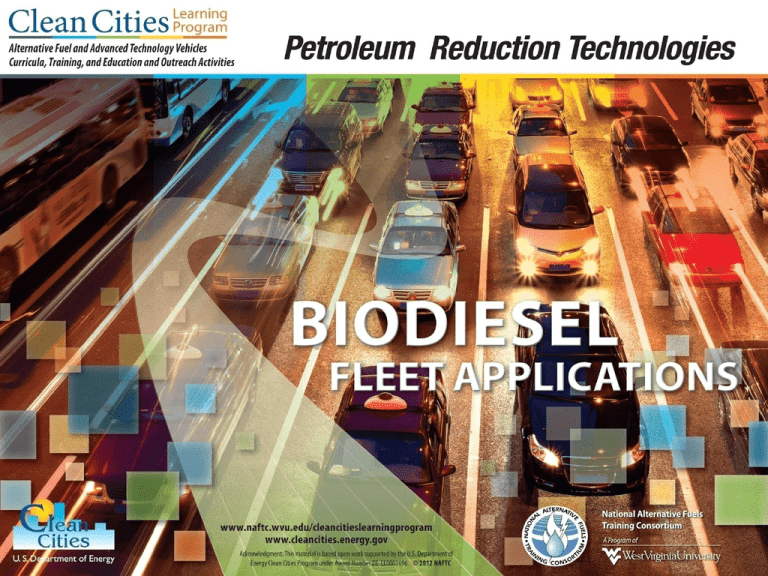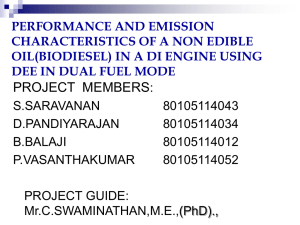Biodiesel Fleets
advertisement

Objectives Explain how to implement green fleets Learn about incentives for converting to biodiesel fleets Learn about the availability and cost of biodiesel fuel Identify the advantages of using biodiesel Understand how to safely handle 2 Greening of Fleets Why use green fleets? Reduce operating costs Reduce greenhouse gas emissions Improve corporate image 3 How to Implement Green Fleets Get buy-in Create long-term objectives Avoid setting reduction goals in absolute numbers Anticipate obstacles Move slowly Improve vehicle use Track and report progress 4 Biodiesel Fleets Conventional diesel = refined petroleum Emissions/pollution concerns Dependence on foreign petroleum supplies Biodiesel = fuel made from natural products Domestically produced Similar to conventional diesel 5 Biodiesel Can Be Made From: Vegetable oil Soybean oil Canola oil Rapeseed oil Palm oil Sunflower oil Peanut oil Recycled cooking oil Beef tallow Algae* 6 Did You Know? Hundreds of U.S. fleets, representing more than 25,000 vehicles from commercial, government, utility, and transit use, currently run on biodiesel. Source: Biodiesel.org. 7 Biodiesel Fleets B20 = most common blend B5 and B2 also popular Heavy-duty vehicles: Buses Farm equipment Military vehicles Figure 1: Biodiesel-fueled bucket truck. Source: AFDC. 8 Biodiesel benefits: Betterment of health and environment Efficiency of our economy Sustained strategic energy security Reduced dependence on foreign oil Pure biodiesel is: Nontoxic Biodegradable Sulfur-free 9 Incentives for Using Biodiesel Fleets inIncentives: Partnership initiatives and pooled resources Financial subsidiaries Informational tools Initial cost vs. federal and state incentives American Recovery and Reinvestment Act 10 Tax Incentives Internal Revenue Service tax credit $1.00/gallon for agri-based biodiesel $0.50/gallon for recycled cooking oil biodiesel Tax credits/rebates vary by state 11 Federal Grant Funding Federal government = largest grant provider U.S. Department of Energy U.S. Department of Transportation Environmental Protection Agency U.S. Department of Agriculture Different Opportunities from each agency 12 State Grant Funding State Energy Office National Association of State Energy Officials directory Alternative Fuels Data Center map Individualized fleet manager resources 13 Incentives for Biodiesel Production U.S. Department of Agriculture Farm Service Agency Biomass Crop Assistance Program: Payment matching for delivery of material to processing Contracts with the Commodity Credit Corporation Feedstock Flexibility Program for Bioenergy Producers 14 Federal incentives are available for producers of bioenergy feedstock. To learn more, visit: www.afdc.energy.gov/afdc/laws 15 Biodiesel Availability and Cost Biodiesel is global European Union produces large amounts of biodiesel U.S. = more than 2,800 retailers 15 manufacturers, more than 17 models 16 Figure 2: Biodiesel fueling stations by state. Source: AFDC. 17 Slightly higher price 20% of biodiesel production capacity vs. 90% conventional diesel production capacity Reduced price gap Figure 3: Diesel and biodiesel cost comparison. Source: AFDC. 18 Biodiesel price depends upon: Cost-blend price availability Conventional diesel price Feedstock prices Weather conditions Processing Distribution Refining capacity Refining location 19 Biodiesel Advantages Domestic production – renewable resources Compatible with most diesel engines Fewer particulate matter/greenhouse gas emissions No new fueling infrastructure needed Creation of jobs Rural development Biodegradable Nontoxic Safe to handle 20 Things to Consider Blends above B5 – warranties Lower fuel economy/power More expensive Higher nitrogen oxide emissions B100 not suitable in low temperatures B100 vs. engine durability 21 Biodiesel Performance and Safety Similarity to ultralow-sulfur diesel: Fuel consumption Horsepower Torque Hauling capabilities Little/no engine and infrastructure modifications Increased lubricity 22 Performance Fuel filter issues Cold weather: Thickening Cloud point Pour point Different blends Cold flow preparation 23 Biodiesel Performance Summary • Similar horsepower to diesel • Natural lubricant • Cleans engines • Faster ignition • Poor cold flow properties 24 Safety Less combustible More biodegradable Higher flashpoint Diamond placards Figure 4: NFPA 704 hazard placard for B100 biodiesel. Source: NFPA. 25 Safety Possible combustion Biodiesel-soaked items Follow specific handling steps Figure 5: Hazardous material UN 1993 placard for diesel. Source: USDOT, PHMSA. 26 Biodiesel Safety Summary • Environmentally safe • Nontoxic and biodegradable • Flashpoint above conventional diesel • NFPA rated minimal fire hazard • Spontaneous combustion risk 27 Test Your Knowledge 1. True or False: The cost of biodiesel depends on the biodiesel blend. (Ex: B20 costs less than B100) 2. Biodiesel is produced from feedstocks such as soy bean oil and vegetable oil. New research also suggests that ____________ can be made into biodiesel. 3. True or False: The biggest obstacle for widespread biodiesel use in fleets, and other alternative fuels, is lack of infrastructure. 4. List one of the three reasons mentioned in the text as to why the U.S. should use biodiesel. 28









